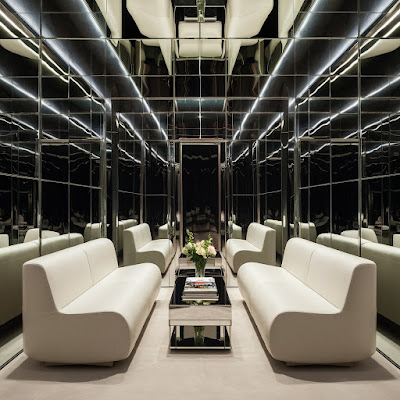When it comes to interior design, small spaces pose a unique set of challenges. Limited square footage can make a room feel cramped and cluttered. However, there are innovative design strategies to make these spaces feel more expansive and inviting. One highly effective technique involves the use of reflective surfaces to enhance light and depth. In this article, we'll explore how reflective surfaces can transform small spaces and provide practical tips for incorporating them into your home.
Understanding Reflective Surfaces
Reflective surfaces, as the name suggests, are materials that bounce light around a room rather than absorbing it. Common reflective surfaces include mirrors, glossy finishes, and metallic materials. These surfaces can be used in various applications, from wall treatments to furniture, to amplify light and create the illusion of greater space.
The Benefits of Reflective Surfaces
Increased Light Reflection
One of the primary advantages of using reflective surfaces is their ability to enhance light within a space. In small rooms with limited natural light, reflective surfaces can help distribute light more evenly, brightening up the area. Mirrors, for example, can be strategically placed to reflect light from windows or light fixtures, making the room feel more open and airy.
Creating Depth and Dimension
Reflective surfaces can also add depth and dimension to small spaces. By reflecting the room’s surroundings, these surfaces create the illusion of additional space. For instance, a large mirror on one wall can make a room appear larger than it actually is. Similarly, reflective furniture and decor items can give the impression of a more expansive environment.
Adding Visual Interest
Incorporating reflective surfaces into your design can add visual interest and a touch of sophistication. Glossy finishes and metallic accents can enhance the overall aesthetic of a room, making it look more polished and stylish. This visual appeal is particularly beneficial in smaller spaces where every element plays a crucial role in the overall design.
Practical Tips for Using Reflective Surfaces
Strategic Mirror Placement
Mirrors are perhaps the most versatile reflective surfaces. When using mirrors in small spaces, consider their placement carefully. Position mirrors opposite windows to reflect natural light and brighten up the room. Alternatively, you can use mirrors to reflect architectural features or artwork, adding interest and creating a focal point.
Glossy Paint and Finishes
Glossy paint and finishes are another way to incorporate reflective surfaces into your design. Choose high-gloss paints for walls, ceilings, or trim to enhance light reflection. Similarly, glossy finishes on cabinetry and furniture can create a sleek, modern look while amplifying light in the space.
Metallic Accents
Metallic materials such as chrome, brass, and gold can be used to add reflective elements to your decor. Consider incorporating metallic light fixtures, furniture, or accessories to introduce a touch of glamour and increase light reflection. Metallic accents work particularly well in contemporary and modern design styles.
Reflective Tiles and Backsplashes
Reflective tiles and backsplashes are ideal for adding a touch of elegance and depth to small spaces like kitchens and bathrooms. Glass or metallic tiles can create a shimmering effect, making the space appear larger and more vibrant. Additionally, reflective tiles can enhance the overall design by adding texture and visual interest.
Mirrored Furniture
Mirrored furniture pieces, such as coffee tables, side tables, and dressers, can be a chic addition to small rooms. These pieces not only add a touch of luxury but also help to reflect light and create the illusion of more space. Just be sure to balance mirrored furniture with other design elements to avoid overwhelming the room.
Reflective Decor Items
Incorporating reflective decor items such as picture frames, vases, and trays can subtly enhance light and depth in small spaces. These items can be used to complement other reflective surfaces and add a cohesive look to the room. Choose decor items with reflective finishes to maintain a sense of unity and sophistication.
Glass Doors and Partitions
Glass doors and partitions are excellent choices for creating the illusion of more space while maintaining privacy. Frosted or clear glass can help to reflect light and make small spaces feel more open. Additionally, glass partitions can be used to separate different areas within a room without obstructing the flow of light.
Lighting Considerations
Lighting plays a crucial role in maximizing the effect of reflective surfaces. Ensure that your room has a combination of ambient, task, and accent lighting to fully take advantage of the reflective surfaces. Proper lighting will enhance the reflections and contribute to the overall brightness and depth of the space.
Avoiding Overuse
While reflective surfaces can be incredibly beneficial, it's important not to overuse them. Too many reflective elements can create a disorienting effect and detract from the room's overall design. Aim for a balanced approach, incorporating reflective surfaces strategically to enhance the space without overwhelming it.
Maintaining Cleanliness
Reflective surfaces can show dust and fingerprints more readily than non-reflective surfaces. Regular cleaning is essential to maintain their effectiveness and appearance. Use appropriate cleaning products and techniques to keep mirrors and glossy finishes looking their best.
Conclusion
Reflective surfaces are a powerful tool for enhancing light and depth in small spaces. By strategically incorporating mirrors, glossy finishes, metallic accents, and other reflective elements, you can create a brighter, more open, and visually appealing environment. Whether you're redecorating a small room or designing a new space, consider the impact of reflective surfaces to make the most of your limited square footage. With thoughtful application, these surfaces can transform even the smallest rooms into inviting and stylish spaces.





.jpeg)

0 Comments